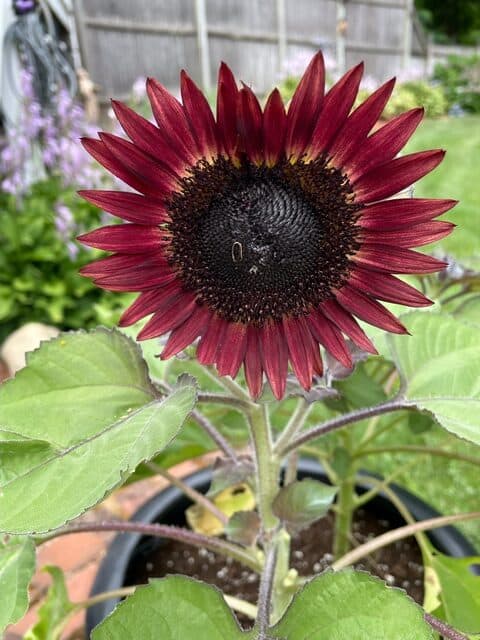Here’s what’s blooming in town this week to make your walks more enjoyable
By Laura Eisener
Sunflowers are annuals which have become very popular in recent years, although they seem to have always been a staple of summer gardens. Bouquets of sunflowers are readily available and are great for arrangements late summer through fall. Some farms in New England and elsewhere plant sunflowers for photo backdrops or just as scenic areas for visitors.
Although the ray florets are most often yellow, varieties with orange or reddish petals draw attention since they are still somewhat unusual. Sandy Mears bought seeds of “Desire Red” sunflower (Helianthus annuus ‘Desire Red’) this year at the Philadelphia flower show and grew them in her Saugus garden, where they are now blooming. The wine-red petals have a narrow golden halo surrounding the dark brown disk florets. The stems are also a dark shade, which gives the whole plant added dramatic interest and contrast to most surrounding plants.
Hydrangeas continue to bloom as summer continues, with later blooming species like panicle hydrangeas (Hydrangea paniculata) showing off their flower clusters. Most varieties of panicle hydrangea have white flowers. Pink varieties are frequently available, but no blue or purple.
Panicle hydrangeas are usually very reliable bloomers, since their flower buds are formed in spring so are not affected by winter winds or temperatures unlike those species which form flower buds the year before. Panicle hydrangeas often grow to 12 feet or more, but shorter varieties like ‘Bobo,’ which average five feet at maturity, can also be found.
Late summer also brings ornamental grasses to the forefront. Grains like wheat and corn are traditionally harvested around this time, and many ornamental species produce intriguing flowers and seed heads at this time of year. Ornamental grasses are grass varieties that are used for purposes other than lawns. They are often used for their interesting textures, subtle colors and continuing interest into late fall and sometimes winter. Since they are pollinated by wind rather than bees or other insects, they are often used in areas where people would prefer not to encounter bees frequently, or in gardens where someone in the household has a bee allergy. Recently I recommended some grasses for an area around and under a net hammock, so the occupant would not be disturbed by buzzing or by the nearby presence of insects disturbing their relaxation. For the same reasons, people sometimes prefer grasses next to a swimming pool or a frequently used walkway. There are quite a few ornamental grasses available in nurseries, including some with colorful striped leaves (several varieties of Miscanthus sinensis), blue toned foliage such as blue fescue (Festuca ovina glauca) and interesting shaped flowers and seedheads (many different species). The grass family (Poaceae, sometimes known as Gramineae) is an extremely large and widespread family.
Several ornamental grasses can be found along the rail trail, especially the stretch from Lincoln Avenue to Central Street along the river. Two species with bluish foliage are especially striking at this time of year. Little bluestem (Schizachyrium scoparium) is a native grass found in wild meadows that gets its common name from the purplish-blue color the stems have in early summer. By this point in the summer the stems have changed to a lighter bluish white tint. As the name suggests, little bluestem is a fairly short grass, growing along the edge of the pavement in several places, and recognizable by its silvery seed heads in late summer.
Switch grass (Panicum virgatum) is another North American grass that has pale blue toned foliage through most of the summer. This is a taller grass that can also be found along the rail trail. It is very adaptable to tidal sections of the river, so can be very effective at erosion control. It can be a larval host to a few species of butterflies.
Monarch butterflies (Danaus plexippus) are appearing around town as well as several other butterfly species. While monarchs rely on milkweed family members for successful breeding, the adult butterflies thrive on nectar from a wide range of other flowers. These colorful winged visitors are a pleasure to see in gardens at this time of year as they gather strength for their long fall migration.
Editor’s Note: Laura Eisener is a landscape design consultant who helps homeowners with landscape design, plant selection and placement of trees and shrubs, as well as perennials. She is a member of the Saugus Garden Club and offered to write a series of articles about “what’s blooming in town” shortly after the outbreak of the COVID-19 pandemic. She was inspired after seeing so many people taking up walking.


